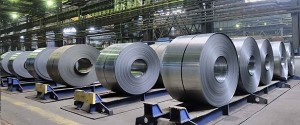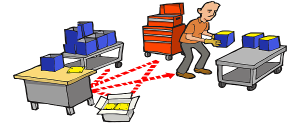
Waiting is one of the 7 Wastes that most people recognize easily. Eliminating time spent waiting has been a focus of manufacturing improvement activities since the industrial age started. The motivation to eliminate wait time has been the driving force behind many of the other wastes. For example, to eliminate any chance of an employee waiting, large queues of WIP would be accumulated throughout the production process. Reducing wait time is an essential objective and important component of lean, but it is just one of the seven wastes.
When people think of wait time, most picture a worker in front of a machine waiting for material to arrive or for the machine to cycle. This is one of the common types of wait time, but there are more subtle instances that are every bit as costly. Wait times are a major challenge in supply chain operations, as companies must wait days or weeks to replenish raw materials. Wait times also occur in many administrative functions, including the delays in the flow of information or approvals from one department to another, or the delay of waiting for an open position to be filled.
Causes of Wait Time
The most basic cause of wait time is an unbalanced process. When one part of a process runs faster than a previous step, there will be waiting in the process. Another common cause of waiting is when materials are not available. This can be due to material handling processes not operating effectively or due to stock outs, as when replenishment inventory is out of synch with production.
The most common causes of wait time are poor communication and poor decision making processes. When employees do not have sufficient information and are not empowered to make decisions, wait time enters the process. This cause of wait time is extremely common in administration functions. The more bureaucratic an organization is, the more wait time due to slow communications and decision making.
Effects of Wait Time
Wait time is pure waste as a resource goes unused. This lost opportunity is easy to see, but is only one type of loss due to waiting. Most companies will not allow workers to sit idly for long periods of time. Even if the cause of waiting is not resolved, the company will usually seek to resume work. The effect of waiting is therefore a change in the plan, and resources are deployed to less than ideal uses to avoid wait time.
Forced plan changes resulting from a desire to avoid wait time cause a wide range of the other problems. One common example is when a raw material is out of stock. The company cannot produce the product required by the customer. Instead, the company overproduces the products for which raw materials are available.
Another common effect of wait time is to paralyze decision making. When information is not available quickly, decisions cannot be made. Often, this leads to missed opportunities. By the time the information is available, the opportunity to use the information is no longer open. Even worse, when information isn’t available and a decision cannot be postponed, people with make less accurate decisions.
Finally, wait time is a primary cause of inefficiency. Every time an employee has to stop because they lack resources or information, they waste time shifting to other activities. In today’s office environment, where an employee may work on dozens or hundreds of tasks every day, wait times can bog a person down and destroy productivity. This type of wait time appears innocuous – a few seconds here, a minute there. Over the course of a day, it adds up to hours. Some researchers have estimated that the average office worker is unproductive more than 35%. Others have estimated that unproductive time is the much more pervasive, with value added time constituting only a small fraction of a worker’s day.
Solutions for Wait Time
Eliminating wait time is usually a straightforward process once the wait time is identified. Eliminating bottlenecks is a typical strategy, as this allows for more balanced processes. When wait time is caused by slow communications and decision making, the company requires structural change. Systems need to be upgraded to ensure information reaches the people that need it. The workforce needs to be empowered to make decisions so that individuals do not have to wait for a decision to arrive.
The most subtle causes of wait time are distractions that slow a worker’s productivity. Eliminating potential distractions is an important step. Often, the distractions appear to be essential. For example, many employees set their computers to notify them when a new email arrives. This notification immediately removes the employee from productive work and places the employee in a wait mode as the employee assesses whether they should act on the email now or later. Some companies have instituted email-free times, when employees shut down their email programs and focus on a single task. Tactics like this are common when implementing lean in an office.




